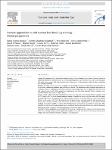Current approaches to soft contact lens handling training – Global perspectives
| dc.contributor.author | Joshi, Mahesh Raj | |
| dc.date.accessioned | 2023-11-13T09:31:57Z | |
| dc.date.available | 2023-11-13T09:31:57Z | |
| dc.identifier.uri | https://pearl.plymouth.ac.uk/handle/10026.1/21633 | |
| dc.description.abstract |
Purpose All neophyte contact lens wearers require training on how to handle contact lenses. Currently, almost no published information exists describing the most common approaches used by those involved in such training in soft contact lens wearers. This study aimed to gather information on the approaches taken by those conducting this training worldwide. Methods An online survey was created in English and translated to Spanish and distributed internationally via social media, conference attendees, and professional contacts. The anonymous survey included information on workplace setting of respondents, information about the typical approaches used for application and removal of soft contact lenses, length of the appointment, and success rate with their approach. Survey responses were received between May 2021 and April 2022. Results A total of 511 individuals completed the survey and responses were received from 31 countries with 48.7% from the UK. The most common approach taught for application was to have the patient hold the upper eyelashes (84.7%) and to hold the lower eyelid with the same hand as the lens (89.4%). Lenses were applied directly to the cornea by 57.7% of the respondents. The most common approach taught for lens removal was to drag the lens inferiorly from the cornea prior to removal (49.3%). Most respondents did not use videos to aid the teaching appointment (62.0%); however, they felt that their approach was successful in most cases (90). Application and removal training sessions lasted a median of 30 min and contact lenses were typically dispensed after the instructor witnessing successful application and removal three times. Conclusion Various methods are adopted globally for training of application and removal of soft contact lenses, with many advising a patient-specific approach is required for success. The results of this survey provide novel insights into soft contact lens handling training in clinical practice. | |
| dc.title | Current approaches to soft contact lens handling training – Global perspectives | |
| dc.type | Journal Article | |
| plymouth.journal | Contact Lens and Anterior Eye | |
| dc.identifier.doi | 10.1016/j.clae.2023.102068 | |
| plymouth.organisational-group | |Plymouth | |
| plymouth.organisational-group | |Plymouth|Faculty of Health | |
| plymouth.organisational-group | |Plymouth|Faculty of Health|School of Health Professions | |
| plymouth.organisational-group | |Plymouth|REF 2021 Researchers by UoA | |
| plymouth.organisational-group | |Plymouth|Users by role | |
| plymouth.organisational-group | |Plymouth|Users by role|Academics | |
| plymouth.organisational-group | |Plymouth|REF 2021 Researchers by UoA|UoA03 Allied Health Professions, Dentistry, Nursing and Pharmacy | |
| plymouth.organisational-group | |Plymouth|REF 2028 Researchers by UoA | |
| plymouth.organisational-group | |Plymouth|REF 2028 Researchers by UoA|UoA03 Allied Health Professions, Dentistry, Nursing and Pharmacy | |
| dcterms.dateAccepted | 2023-11-08 | |
| dc.date.updated | 2023-11-13T09:31:57Z | |
| dc.rights.embargodate | 2023-11-14 | |
| rioxxterms.versionofrecord | 10.1016/j.clae.2023.102068 |


